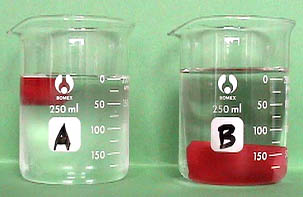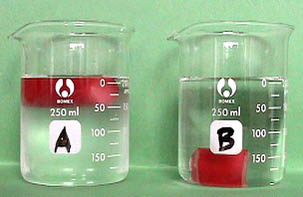Density Curriculum
Section 4—Lesson 13: Dropping an Object into a Liquid: How Does Density Affect Sinking or Floating?
Lesson Plan
Materials
- 2 600 ml beakers marked A and B
- Equal amount of water (A) and rubbing alcohol (B), approximately 16 fluid oz of each
- 2 pieces of candle wax from the same candle, same color and circumference, 1 one-inch long piece, 1 two-inch long piece
- Paper towel
- Some clay and wax (another piece of candle is fine)
- RECAST Activity: Two Candles sheet (PDF 71 KB)
- Thinking About Relational Causality sheet (PDF 71 KB)
- Mapping Relational Causality: Sinking or Floating sheet (PDF 105 KB)
- Student Examples: Making Connections Between Relational Causality and Everyday Life (PDF 200 KB)
Prep Step
- Review the lesson plan, background information, and understanding goals.
- Gather materials.
- Test the candle and alcohol experiment ahead of time. It works with most candles. However, not all candles are the same density. You can adjust the candle pieces and the percentage of alcohol (Most stores carry a range of 70 to 91%) until the candle sinks in the alcohol and floats in the water.
- Build a small object using clay and wax that will suspend in water. You can build it by trial and error. You will need to match the density of water (1.0 grams per milliliter (g/ml).
- Before class begins, fill Beaker A with about 500 ml of water, and Beaker B with about 500 ml of alcohol. Make the two beakers as identical as you can.
- Photocopy the sheets: RECAST Activity: Two Candles; Thinking About Relational Causality; and Mapping Relational Causality: Sinking or Floating.
Analyze Thinking
Step 1: What Causes Something to Sink or Float?
Ask the students to answer the following question either in their journals or on a sheet of paper. "What causes an object to sink or float in a liquid? Draw a model to think through your ideas and then write an explanation."
Circulate while students are working to make sure that they understand the question. You may wish to ask them to consider how density is a part of what happens. Some students will also include non-density related explanations such as surface tension, buoyancy, etc. Give the students about ten minutes to think about their response. Don't have the students share their ideas just yet.
RECAST Thinking
Step 2: RECAST Activity: Two Candles
This activity3 explores the role of density in sinking and floating and reveals the relational causality involved. Pass out the sheet, RECAST Activity: Two Candles.

Do this activity as a demonstration. Do NOT foreshadow what will happen. Introduce the problem to the students by explaining that you have two beakers filled with liquid, and two pieces of candle, one large, and one small (the pieces are from the same candle). Drop the smaller candle in Beaker A [it floats] and the larger candle in Beaker B [it sinks]. Instead of having students discuss their ideas out loud describing what happened and why, ask them to answer question #1 on the sheet. After everyone has finished writing, remove the candles from the beakers.

Next, switch the candles. Drop the smaller candle in Beaker B [it sinks] and the larger candle in Beaker A [it floats]. Ask the students to notice what happened and answer question #2 on the sheet.
Have the students share their reactions. Were they surprised about what happened? How did the demonstration change what they were paying attention to? The activity forces their attention to the liquid, which beforehand had been non-obvious to them.
Whether an object sinks or floats in a certain liquid depends upon the density of the object and the density of the liquid. If the density of the object is greater, it will sink. If the density of the liquid is greater, the object will float. Ask students what they think will happen if the density of the object and the density of the liquid are the same? [The object will suspend.] Gather their ideas.
Demonstrate what it means to suspend by putting the object that you prepared before class into the beaker of water.
Explore Causality
Step 3: Discussion of Linear Versus Relational Causal Models
Explain the difference between a Linear Causal Model of what happened and a Relational Causal Model. Hand out the sheet, Thinking About Relational Causality. How does each model apply to the candle problem?
Pass out the sheet entitled, Mapping Relational Causality: Sinking or Floating. Walk the students step-by-step through the questions on the sheet. When determining whether or not an event is best described by Relational Causality, ask:
- In Relational Causality, there is more than one thing in the model. Is there more than one "thing" in this model? What are the things?
- In Relational Causality, it is the relationship between the two things that accounts for the outcome. Look for balance or differences in amount and what happens in the different cases (are the two things equal, or is one greater than the other?) Does the relationship between them (how much you have of one compared to how much you have of the other) cause the outcome?
Step 4: "Sinking or Rising?"
Pose the following question to your students: "Some people don't use the terms, 'sinking and floating,' instead they say 'sinking or rising.' What do you think about using these terms?"
During the discussion, demonstrate how, if you push an object that floats to the middle of the column of liquid (where items normally suspend), it rises to the top.
Ask, "How does using the word 'rising' change our thinking?" Gather ideas. If no one brings it up, introduce the idea that the role of the liquid can be non-obvious or seem passive. However, showing how an object rises makes us more likely to notice the role of the liquid. It makes it seem more active—in the sense of pushing on the object.
Review, Extend, Apply
Step 5: Making Connections: Relational Causality and Everyday Life!
Explain to your students that Relational Causality and density were introduced in this lesson.
Ask:
Where else have you noticed that differences in density explain what is going on? In making connections like this, it sometimes helps to "take a mental walk" through your day or through your home to help remind you of what you do or see there. What about when you are preparing food, washing dishes, running a bath, playing in the ocean? Try to find three examples that might have to do with relative density. Write 3-4 sentences explaining each one. You don't have to be positively sure that your examples have to do with relative density, just pretty sure (see Student Examples: Making Connections Between Relational Causality and Everyday Life).


